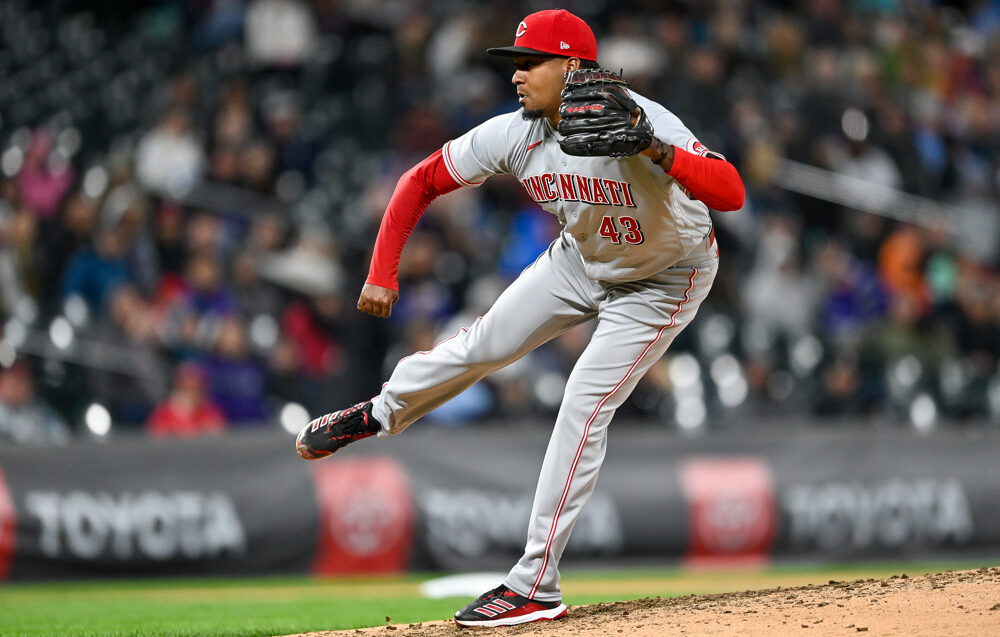
There haven’t been many feel-good stories for the Reds pitching staff in 2022. The rotation, by almost all measures, has been the worst in baseball. For the most part, the bullpen hasn’t been a whole lot better, even if it has been an improvement over the 2021 train wreck.
One pitcher has stood out with his early-season performance, though — and it’s not someone who was really on the radar before the year began: Alexis Díaz.
Through his first 13 career appearances, Díaz has shown he’s more than Edwin’s younger brother. The 25-year-old has allowed only one run, seven hits, and six walks while striking out 16 hitters in 14 innings. While his 0.64 ERA isn’t sustainable, the underlying metrics are still strong for Díaz (2.47 xERA, 3.22 FIP, 3.80 xFIP). Díaz has dominated most hitters, but he’s been otherworldly against right-handed batters, holding them to a .120/.241/.120 slash line and striking them out 38% of the time.
Oh, and did you know he skipped Triple-A? Díaz was a 12th-round pick in 2015 and was brought along slowly, partly due to injury. But he put up big numbers in Double-A Chattanooga last season (38.9% strikeout rate, 3.17 xFIP), prompting the Reds to add him to their 40-man roster in the offseason to protect him from the Rule 5 draft. He showed enough to make the team out of spring training and hasn’t looked back.
How is he doing it?
It starts with Díaz’s premier pitch: his four-seam fastball. Díaz throws hard, averaging 95.5 mph with his heater. That puts him in the 81st percentile. But what makes the pitch unique is its spin rate. The four-seamer averages 2,712 rpm. No other pitcher in baseball has a higher average spin rate with their fastball. Due to his low arm delivery, Díaz doesn’t get a ton of pure backspin on the pitch, which limits the “rise” it gets. This is evidenced by his 71% spin efficiency, which is one of the worst marks for any fastball in the game.
But Díaz gets it to work anyway. Largely using the heater up in the zone, he’s allowed a .121 batting average (.162 xBA), .121 slugging percentage (.284 xSLG), and .194 weighted on-base average (.258 xwOBA). The pitch also has a 33.7% whiff rate, well above the league average four-seamer (21.5%). Only seven pitchers who’ve thrown at least 100 four-seamers this season have a better whiff rate than Díaz. Eleven of Díaz’s 16 strikeouts have come on his heater.
His fastball has accumulated a -5.1 run value (negative is good for pitchers), the 13th-best mark in baseball. Only one pitcher who’s thrown at least 100 four-seamers this year has allowed a lower hard-hit rate than Díaz (17.4%).
You get the point. The pitch has been incredible.
OK, but how is Díaz doing this? Raw spin rate is good, but how is Díaz getting results like this without spin efficiency?
He’s aided by the arm angles he uses. Díaz pitches nearly sidearm as he sweeps the ball across his body and toward the plate. It’s an awkward angle for a hitter, and the fastball’s velocity only makes that more difficult. Here’s a great example against Brewers star Christian Yelich:
That’s not Díaz’s only weapon, though. His other secret is something that’s hard to perceive from a center-field camera angle. It’s something that Aroldis Chapman also does.
Díaz gets tremendous extension in his delivery. In layman’s terms, he gets close to home plate when he releases a pitch. That means the ball gets on hitters quickly and they have less time to react. Despite relatively modest height (6-foot-2), Díaz gets 7.4 feet of extension on average, a number bested by only two other pitchers in baseball (Steve Cishek and Devin Williams). It may not be a coincidence that his brother, Edwin Díaz, is right behind him at 7.3 feet of extension. To put it in perspective, the tallest active pitcher in the game — the Twins’ Bailey Ober — stands at 6-foot-9, and he gets 7.2 feet of extension on average. Chapman is at 7.1 feet.
As a result of his extension, Díaz’s fastball has an average perceived velocity of 97.8 mph — over 2 mph faster than his actual velocity. How many other pitchers have such a stark difference between actual and perceived velocity? Not many.

Does that make his fastball unhittable? Of course not. But paired with his already funky arm angle, it makes Díaz’s fastball extremely difficult to hit. It’s no wonder he throws it 70% of the time.
Of course, Díaz throws another pitch, too. His slider, which also gets elite spin, has a 38.2% whiff rate and has held hitters to a .200 average (.215 xBA). The breaking ball gets about two inches of drop above average and has proven lethal against right-handed batters with a 50% whiff rate. Here’s a look at the pitch against former Reds outfielder Adam Duvall:
Final Thoughts
It’s still very early in Díaz’s career, and the league will surely adjust to him. Pitchers can’t get by on good extension, spin rate, or velocity alone. He’ll need to cut down on his free passes (10.7% walk rate) and learn to miss left-handed bats (24.2% whiff rate) the same way he does right-handers (46.6%). But Díaz’s unique and, in some respects, elite abilities make him one of the most intriguing and exciting young arms in the Reds’ organization.
Soon, that could help him graduate from low- and mid-leverage innings to high-leverage situations.
Photo by Dustin Bradford/Icon Sportswire


